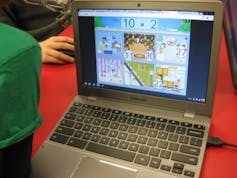More and more teachers are turning to technology when assigning homework. But while e-homework can make out-of-class learning more fun and interactive, research suggests that it might further disadvantage students from low socio-economic families.
What is e-homework?
E-homework is the practice of using digital hardware and software such as iPads, laptop computers and smartphones with internet connectivity in homework assignments.
It requires that students have access to, and are familiar with, a growing number of educational programs, apps and technologies. These can include new and emerging technologies such as global positioning systems (GPS), satellite imagery, GPS geocaching experiences, augmented reality and 3D virtual world adventures.
E-homework has many advantages: it’s engaging and motivating for students, and simple and efficient for teachers to use.
Increasing the gap
But a Victorian parliamentary inquiry last month found that e-homework assignments may be contributing to widening the gap between our richest and poorest students.
The inquiry noted:
A lack of technology in the home can hamper the ability of students to complete their homework and also participate in class discussion the following day.
A submission to the inquiry by Good Shepherd Youth and Family Service stated:
Technology is now intrinsic to a great deal of the learning pursued in schools, but is placing inequitable, and at times unsustainable, financial pressure on some families.
The submission cited the case of a 10-year-old boy who was unable to do maths homework as it required access to the educational website Mathletics and his mother couldn’t afford to pay their internet bill. Aside from affecting the boy’s participation and performance in school, the situation also contributed to increased family stress and conflict.
Teachers often assume, quite wrongly, that contemporary schoolchildren have ubiquitous access to technology and the internet. But 2011 ABS data shows that only 55% of families in the lowest income bracket with children under the age of 15 have access to the internet. In comparison, 95% of equivalent families in the highest income bracket have access.

A Smith Family report found that children who did not have access to the internet at home felt excluded. They struggled to participate fully in class and homework activities.
The report found that the high cost associated with learning technologies was the main reason that families did not invest in technology tools with internet access. What’s more, one in five parents surveyed said they had insufficient knowledge of how they worked.
The report found that this lack of digital literacy of low socio-economic parents further contributed to widening the gap between children from rich and poor families.
International research has also clearly established that homework assignments given by teachers, particularly e-homework, are often too difficult for some students from non-English-speaking backgrounds and those with physical or intellectual disabilities, or learning difficulties such as dyslexia.
The benefits of e-homework
Despite the disadvantages that e-homework poses to some students, it’s not surprising that teachers are drawn to the idea of increasingly assigning e-homework.
E-homework is motivating and engaging for students. Research shows that young people enjoy the convenience of anywhere, anytime access to web-based homework, as well as the instant feedback features that many online systems provide.

Online homework tasks can allow students to practise particular skills and provide them with multiple attempts to complete homework questions.
It has also been found to help lift student achievement. Researchers from a US university found that switching from weekly quizzes to online homework for undergraduate chemistry classes significantly improved student success in the course.
The research found that students were highly likely to complete the e-homework and to feel that it was worth the effort. Three-quarters of the students surveyed said that their study habits were more consistent with e-homework. Over 85% wanted to continue to do homework online.
Educators see e-homework as a useful way to increase student learning engagement without also increasing teachers’ heavy workload. E-homework cuts down on the time it takes to distribute, collect and grade homework.
The Australian Curriculum’s emphasis on critical and creative thinking and the implementation of “digital solutions” may also have contributed to the increase in teachers assigning e-homework in Australia.
Increasing access
So how do we ensure that all students can reap the benefits of e-homework?
According to the Good Shepherd submission to the Victorian parliamentary homework inquiry, the first step for schools is to stop assuming that all students have access to digital technology at home.

Good Shepherd recommends that schools provide at-school computers that are set aside for non-teaching use, and create specialised homework spaces at school.
The submission also stresses the importance of Student Resource Packages that provide for the technology required by schools.
The submission recommends that when the Education Maintenance Allowance ceases at the end of this year, the Victorian government creates a new “Participation Package” for parents with Health Care Cards that includes a specific technology allowance.
In order to prevent a focus on technology from further disadvantaging low socio-economic students, it’s vital that teachers understand that their students have varying needs, capabilities and levels of access to resources and materials. To ensure that all students are able to succeed, teachers need to have a greater understanding of the role that the “home” plays in homework.

